Mark Sisson's Blog, page 239
December 20, 2015
Weekend Link Love – Edition 379

Research of the Week
When it comes to greenhouse gas emissions, eating lettuce is worse than bacon.
Top scientists hold back science.
Humanely-killed fish taste better.
Human sleep efficiency (short but deep) developed in part because it allowed us to throw amazing parties late into the night.
New Primal Blueprint Podcasts

Episode 98: Stacy Toth: I hang out with the Paleo Parent herself. We talk about her journey to (and maintenance of) healthy weight loss, staying paleo in a corporate setting, incorporating movement and paleo eating throughout the day, and how a walking treadmill desk is the key to her success, and maybe yours.
Each week, select Mark’s Daily Apple blog posts are prepared as Primal Blueprint Podcasts. Need to catch up on reading, but don’t have the time? Prefer to listen to articles while on the go? Check out the new blog post podcasts below, and subscribe to the Primal Blueprint Podcast here so you never miss an episode.
Do You Know How to Properly Hydrate?
Winter Blues: How Cold, Dark Days Can Take a Mental Toll
Also, be sure to check out and subscribe to the Primal Endurance Podcast.
Interesting Blog Posts
Researchers think doctor’s visits should include exercise checks.
What fasting does for the brain.
A nice response to the “Cowspiracy” film.
Media, Schmedia
Quitting meat won’t save the planet.
Why parents need to stop controlling how their kids play.
Everything Else
Google’s Play Books app just added a blue light filter.
Pepsi vending machines to feature “healthy” fare only.
What walking across the world feels like.
Sure, I’m ready.
Chronic stress may be fueling the asthma epidemic.
Obama signs a “Free Range Kids” act.
Where does one species end and the next begin?
Recipe Corner
Scrambled eggs are better with extra yolks.
Nothing like a hearty soup when it’s cold out. This beef, mushroom, and onion soup fits the bill.
Time Capsule
One year ago (Dec 22 – Dec 28)
The Ultimate Cheat Sheet for a Happy and Healthy Primal Christmas – Do Christmas right.
10 Ways to Stay Healthy During Holiday Travel – And stay healthy.
Comment of the Week
Agreed. Baboon balls are natural too, but I’d love to know if they’re the thing that’s flavoring my food!
– Fear not, Kathleen. Our bars use only the finest macaque balls.
Like This Blog Post? Subscribe to the Mark's Daily Apple Newsletter and Get 10 eBooks and More Delivered to Your Inbox for FREE



December 19, 2015
Roasted Bone-In Leg of Lamb
 A bone-in leg of lamb is a cut of meat that’s the perfect choice for a formal holiday table or a casual backyard dinner. Slather a marinade on the outside, roast the leg slowly for a few hours then crank up the heat to crisp up the outside. It doesn’t matter what you serve on the side, because the leg of lamb will get all the attention.
A bone-in leg of lamb is a cut of meat that’s the perfect choice for a formal holiday table or a casual backyard dinner. Slather a marinade on the outside, roast the leg slowly for a few hours then crank up the heat to crisp up the outside. It doesn’t matter what you serve on the side, because the leg of lamb will get all the attention.
Of course there are health benefits that make lamb a good choice—all 8 essential amino acids, B vitamins, niacin, zinc, iron and conjugated linoleic acid (CLA) to name a few – but that’s not what most people are thinking when they look at a bone-in leg of lamb. What they’re thinking is, “Now that is an impressive cut of meat!”
The variation in shape—thick on one end, thin on the other with a bone sticking out—is what makes a leg of lamb such an eye-catching centerpiece. The shape also results in meat that cooks differently, ranging from rare to medium well. Luckily, such a large cut of meat requires a large group of people to eat it, and everyone will have at least one part of the leg that’s cooked exactly to their liking.
Servings: 8
Time in the Kitchen: 25 minutes of hands-on cooking, plus approximately 9 hours to marinate and bring back up to room temperature, and 2 hours to cook.
Ingredients:
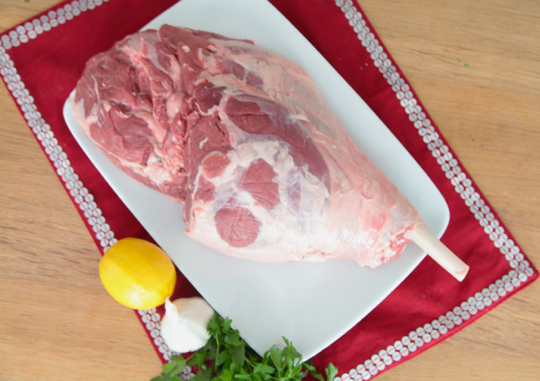
6 to 8 pound bone-in leg of lamb (2.7 to 3.6 kg)
1/4 cup extra virgin olive oil (120 ml)
Juice from 1 lemon
8 garlic cloves
1 cup loosely packed parsley leaves (240 ml)
2 tablespoons smoked paprika (30 ml)
2 teaspoons coriander (10 ml)
1 teaspoon cumin (5 ml)
1 tablespoon plus 1 teaspoon kosher salt (15 ml + 5 ml)
Instructions:
First, prepare the lamb:
A thin to medium layer of fat around the meat is desirable because fat, as we all know, gives meat flavor. But go ahead and trim down any really thick areas of fat, since too much lamb fat can make the meat overly gamey and greasy.
If there is flesh covering the end of the long shank bone, scrape it off with a knife to reveal the bone.
Use the tip of a knife to make a dozen or so slashes in the meat, about 1 inch long and 1/2-inch deep, so the marinade can penetrate better.
Pulse the olive oil, lemon juice, garlic, parsley, paprika, coriander, cumin and salt in a food processor until the garlic is very finely chopped. Drape two long pieces of plastic wrap over a large container that will fit the leg of lamb. Set the lamb on the plastic wrap. Rub the marinade all over the meat, letting the plastic wrap catch any drips, then wrap the meat tightly and marinate overnight in the refrigerator.
Remove the lamb from the refrigerator. Blot the meat dry. Let the meat come up to room temperature (45 minutes to 1 hour).
Preheat oven to 325 °F/163 °C.
Place the lamb, fatty side up, on a rack in a roasting pan. Pour 2 cups of water in the bottom of the pan. Roast until a meat thermometer inserted into thickest part of flesh reads 130 °F/54 °C, about 2 1/2 hours, although the cooking time can vary so start checking the temperature after 1 1/2 hours.
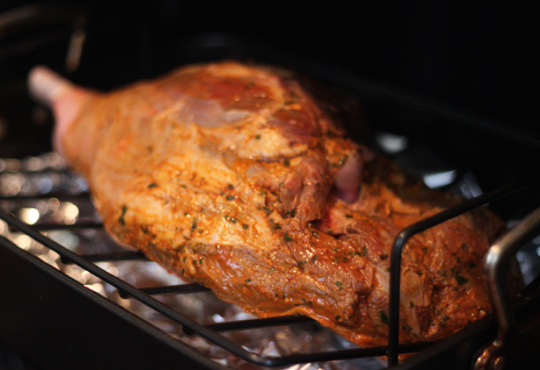
Turn the broiler on; broil until that fatty surface is sizzling and crisp, about 5 minutes. If the meat begins to burn, it’s too close to the broiler.
Remove the leg of lamb from the oven and let rest for 20 minutes before carving.





December 18, 2015
Happy, Healthy, and Feeling Better Than Ever
It’s Friday, everyone! And that means another Primal Blueprint Real Life Story from a Mark’s Daily Apple reader. If you have your own success story and would like to share it with me and the Mark’s Daily Apple community please contact me here. I’ll continue to publish these each Friday as long as they keep coming in. Thank you for reading!
 I remember being as young as six and my mother taking me to the doctor’s, complaining how underweight and pale I was. I’d end up going to the lab for tests and then back to the doctor, to have him tell my mother my iron was low. This went on my entire childhood. I clearly remember to this day, the awful tasting liquid iron supplement I had to take daily, the raw egg shakes I was forced to consume because the doctor said so, the time I wanted a beautiful blue jacket but my mom insisted I buy the green one instead, because I didn’t look as pale in it. I had terrible eczema and environmental allergies and my nose would bleed spontaneously. I was a wreck as a child, awkward, gangly and sickly.
I remember being as young as six and my mother taking me to the doctor’s, complaining how underweight and pale I was. I’d end up going to the lab for tests and then back to the doctor, to have him tell my mother my iron was low. This went on my entire childhood. I clearly remember to this day, the awful tasting liquid iron supplement I had to take daily, the raw egg shakes I was forced to consume because the doctor said so, the time I wanted a beautiful blue jacket but my mom insisted I buy the green one instead, because I didn’t look as pale in it. I had terrible eczema and environmental allergies and my nose would bleed spontaneously. I was a wreck as a child, awkward, gangly and sickly.
As I entered my 20’s I suffered from heavy cramps and periods. I birthed two wonderful children and barely remember their early years as I was exhausted 24/7. During both pregnancies I was anemic. After kids, I started the birth control pill, thinking it would help lighten my period. The pill worked for a few months, but then the heavy periods kicked in again, so I tried an IUD but that didn’t help either. I also noticed after I had children I was lactose intolerant. I couldn’t drink a glass of milk without it going right through me. I wanted to exercise, but I was truly too exhausted and cranky.
Six years ago I started CrossFit. I loved it and before long, I was introduced to the Paleo Diet, and did a 30 Day Challenge. During that time I had lab work done, and my doctor tested me for celiac disease. The test was negative but because I hadn’t been consuming gluten on the 30 Day Challenge, those results weren’t sound. I felt great and when the challenge was done, I went back to eating gluten and grains.
In 2012, I was back to the doctor’s complaining of fatigue, shortness of breath and not recovering well from workouts. My lab tests came back showing low ferritin, even though I had been taking a daily supplement for years. I had ten painful iron injections while waiting to see the hematologist. My ferritin went up and would drop again, when I got my period. The hematologist explained I just don’t absorb iron well and put me on an expensive, highly absorbable, iron supplement. Again – no success.
In May 2013 I had a laprascopic hysterectomy which I thought would cure the anemia, because I’d no longer have my period. Six months later, I found I was exhausted again.

December 2013 – I am in the middle wearing black and white stripes (my girlfriend to my left, the tall one, is an avid fan of your site).
In February 2014, I was so tired, short of breath, and battled insomnia. Blood work showed I was even more anemic than I was before my surgery. I started iron supplements again and waited for an appointment with the hematologist. He explained, one more time, I just don’t absorb iron well and said I need to supplement for the rest of my life.
During the past few years I also put on about 15-20 pounds, doctor said I’m getting older and just need to simply cut my caloric intake. I did calorie count for a couple of weeks, however, that led to frustration. It was difficult and time consuming to track everything, and I was disappointed I kept going over my allotted caloric allowance every single day. I tried those diet pills with lots of caffeine. Whatever fad/pill was out there, I actually tried it or gave it serious consideration.
I was frustrated, depressed, tired and noticed it was taking days to recover from a workout. My feet swelled up if I ran, and working out in general was not something I enjoyed anymore. I needed help.

June 2014 – I’m 3rd on the left. I was so swollen after this race and had a week of achiness.
In September 2014, I brought my blood test results to a naturopath – someone who according to reviews was known for emphasis on food rather than medication. I’ll never forget my first visit. He looked at my lab results and said it was gluten. I can’t remember everything he told me in detail, but at that point I was desperate for help. He also thought I was pre-diabetic based on my terrible cravings and insomnia. We discussed a food plan, which turned out to be pretty much a Paleo diet.
I found Mark’s Daily Apple during the Paleo challenge and subscribed to the newsletter. It wasn’t until my visit with the naturopath, I decided to spend some time on the MDA site, which I found to be a wealth of information. I also read one of Mark’s books and purchased the recipe book which I still use.
I saw the naturopath monthly and it kept me accountable. I lost 25 pounds over the course of a few months, and gained my health back. After the transition period, gone were the IBS symptoms, headaches, bags under my eyes, cravings, fatigue, crankiness, constant hunger, insomnia, shortness of breath, swelling, etc. Friends were commenting on how wonderful my skin looked and how happy I was.
 I went for a check in with the hematologist six months later. My ferritin was the best it had ever been, he commented on how he had to double check my file and see if I had in fact received iron infusions. I told him about my Paleo lifestyle and he actually raised his hands in the air and cheered!!! I was still supplementing with iron to build my ferritin levels, but the difference was, I was actually absorbing it. My family doctor was just as surprised. I have now stopped iron supplements and my ferritin level has held strong. I CrossFit, run and cycle four to six times a week, and I can handle my crazy shift work schedule.
I went for a check in with the hematologist six months later. My ferritin was the best it had ever been, he commented on how he had to double check my file and see if I had in fact received iron infusions. I told him about my Paleo lifestyle and he actually raised his hands in the air and cheered!!! I was still supplementing with iron to build my ferritin levels, but the difference was, I was actually absorbing it. My family doctor was just as surprised. I have now stopped iron supplements and my ferritin level has held strong. I CrossFit, run and cycle four to six times a week, and I can handle my crazy shift work schedule.
I’m 38 and feel the best I ever have. I’m happy, healthy and energized. It took a lot of hard work, determination, organization and preparation to get to where I am, but there’s no going back because this is amazing. My children, family and friends have seen the difference in me and love it.
Bonnie




December 17, 2015
Psychedelics: A New Medical Frontier?
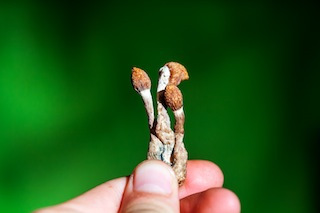 Long before humans interacted with the numinous through intermediaries and holy books, we experienced it in other ways. All night drumming and dancing sessions, extended fasts, exposure to extreme temperatures, steam lodges, and week-long wilderness forays, and other rituals have all been used to produce visions and transcend normal waking consciousness. There’s even a theory that early Christian baptisms were actually simulated drownings that produced near-death experiences and the direct sensation of being in the presence of a higher power.
Long before humans interacted with the numinous through intermediaries and holy books, we experienced it in other ways. All night drumming and dancing sessions, extended fasts, exposure to extreme temperatures, steam lodges, and week-long wilderness forays, and other rituals have all been used to produce visions and transcend normal waking consciousness. There’s even a theory that early Christian baptisms were actually simulated drownings that produced near-death experiences and the direct sensation of being in the presence of a higher power.
But perhaps the oldest, most reliable way to directly experience the divine is through the use of psychedelics.
From rotting fruit to honey made by bees feeding on psychotropic plants to desert toad secretions to the tantalizing mushrooms sprouting up from ruminant dung to the IPA in your fridge, humans have always pursued and consumed substances that alter consciousness and provide different takes on reality. And yes, this can be fun. It’s certainly recreational. But in most traditions, psychedelics also offered a way to make sense of the natural world, investigate its mysteries in person, visit the spirit realm and contact lost ancestors for advice, reassurance, or resolution of disputes. These weren’t the sole province of jungle or desert tribes; archaeological evidence suggests that even prehistoric Europeans used opium, cannabis, and mushrooms in religious rituals.
In a world of cold empiricism, with doctors and pills and psychiatrists and online resources storing every bit of knowledge and wisdom available, does a legitimate role for psychedelics remain?
It turns out there is: after a half century of prohibition destroying the careers of any researcher seriously considering the medical application of psychedelics, research is making a big comeback. Emerging research shows these substances can have incredible therapeutic effects across a range of seemingly intractable and drug-resistant conditions like depression, PTSD, anxiety (especially end-of-life anxiety), addiction, and marriage counseling. The science is quite impressive—and it’s growing every month.
I know, I know. Sisson, you shouldn’t be encouraging people to take mind-altering drugs. First of all, I’m not encouraging anyone to do anything. Second, so many people have emailed me about this topic over the years, I felt obliged to finally give it a thorough look. Last, take a look at the recent clinical research into the medical applications and safety profiles of these compounds, seek out and consult with experts if you’re interested in digging deeper, and judge for yourself.
LSD (AKA: Acid)
Lysergic acid diethylamide strikes fear into the hearts and minds of many otherwise reasonable folks. Some think it’ll fry your brain, make you think you can fly out a ten story window, or turn you into a hippy. But even if those things were widespread (they’re not), the fearmongers must admit that LSD is also responsible for the latter half of the Beatles’ catalogue and, thus, a net positive force in the world.
LSD is a tryptamine, a class of psychedelic alkaloids bearing close structural similarity to the amino acid tryptophan, a precursor to serotonin. LSD acts as an agonist to the 5-HT2A serotonin receptors, and this interaction appears to be responsible for the effects which in addition to the well-known open and close-eye hallucinations include increased subjective well-being, closeness to others, happiness, openness, and trust.
Throughout the 1950s, when it was still legal, psychiatrists recognized these effects and used large doses of LSD to induce boundary-dissolving states of catharsis, enabling their patients to work through seemingly intractable problems and reduce anxiety and depression. Several subsequent studies found that these effects could also reduce end-of-life anxiety in terminal cancer patients. After LSD was made illegal in 1966, research stopped in the United States until very recently.
A 2014 study in adults with life-threatening illnesses came to similar conclusions as the older papers, finding that LSD paired with psychotherapy sessions actively reduced anxiety and improved quality of life. These improvements persisted in the experimental LSD group for at least a year, while the placebo group’s anxiety only worsened. If “lower anxiety” doesn’t sound like a big deal, consider how many terminal patients live their final days: in an anxious, scattered state of mind that inhibits them from making peace with their life and spending meaningful time with loved ones. Wouldn’t you want to avoid that?
Psilocybin-containing Mushrooms (AKA: Shrooms, Magic Mushrooms)
Ever hear of the Stoned Ape? It’s a theory put forth by Terence McKenna, and goes like so:
When African hominids descended from the trees and began hunting, they’d follow the vast herds of wild ruminants. Inevitably, they’d happen across large amounts of ruminant dung, which is the perfect medium for growing psychedelic mushrooms. The more curious of the opportunistic bipeds would sample the mushrooms and experience a few unique, fitness-enhancing effects—an increase in libido (good for creating similarly curious hominids), a boost to visual acuity (great for hunting), a dissolution of the ego (which promoted the formation of close communities and consensual egalitarianism). In addition, the increased connectivity between previously disparate regions of the brain catalyzed linguistic capabilities and self-expression, eventually expanding our creative and cognitive abilities and our capacity to articulate them.
I don’t really buy it, to be honest, but it’s fun to consider. And at any rate, psychedelic mushrooms appear on every inhabited continent and are likely the most widely-used hallucinogen throughout human history. We have a long tradition of finding, eating, and maybe revering these things. Psilocybin is also a tryptamine. Like LSD, psilocybin is a 5-HT2A serotonin receptor agonist.
Channeling William Blake, Aldous Huxley suggested that psychedelics deactivate the “reducing valve” and throw open the “doors of perception” so that the world becomes infinite. He might have been right. fMRI research indicates that when a person takes psilocybin, activity in the part of the brain responsible for processing incoming sensory data, discerning information important for survival, and making sense of the world—the “filter”—dampens.
Psilocybin also reduces amygdala reactivity in healthy subjects; those with the greatest reduction in amygdala activity had the biggest mood enhancements. If these results persist in patients with depression or anxiety (in whom the amygdala is often overexcited), psilocybin mushrooms could be an effective treatment.
Like LSD, psilocybin also shows promise for combatting end-of-life anxiety in terminal patients.
MDMA (AKA: Ecstasy, Molly)
MDMA is an empathogen/entactogen; it floods the brain with serotonin, oxytocin, dopamine, shattering the barriers we erect between ourselves and others, boosting empathy to supranormal levels, and fostering honest and uninhibited communication. Before it became a club drug, MDMA was a valuable, if off-the-books, tool psychotherapists and marriage counselors used to enhance the efficacy of their clinical practice. A clever therapist could cram an incredible amount of progress into the three or four hours the drug was active in the subjects.
Today, researchers are exploring MDMA as a treatment for treatment-resistant post-traumatic stress disorder (PTSD). Animal studies confirm that MDMA can facilitate “fear extinction.” Preliminary human trials with vets have been promising. It appears to be safe. Reports from actual vets who’ve participated in MDMA trials are glowing. In war veterans who’ve tried other treatments and failed, MDMA combined with psychotherapy may help by quieting the amygdala (the “lizard brain” responsible for processing fear) and activate the frontal cortex (where contextualization occurs).
Ketamine (AKA: Special K)
Ketamine is a veterinary tranquilizer. In doses that won’t quite fell a horse, ketamine is a dissociative—it promotes a feeling of detachment from one’s body and the physical world. Of all the drugs discussed today, ketamine may be the hardest to conceptualize without actually doing it. I’ve never tried it and am certainly having trouble imagining it. In recent years, researchers have stumbled upon a remarkable side effect: short-term, complete elimination of depression.
Single doses of ketamine provide rapid amelioration of depression symptoms lasting for weeks. Even low doses of ketamine are able to improve symptoms of treatment resistant major depressive disorder for one to two weeks.
Ketamine increases brain-derived neurotrophic factor (BDNF) in the hippocampus. This seems to mediate the anti-depressant effect and suggests that long-term low-dose ketamine treatment may actually heal the depressed brain by regrowing damaged neurons, rather than just temporarily mask the symptoms. Still, only short-term efficacy has been demonstrated. It remains to be seen if medium- to long-term benefits persist.
Ketamine for depression is an off-label use. It’s possible to obtain from your doctor, but your doctor may need convincing. A better bet is to contact one of the ketamine clinics currently operating in the United States.
Ayahuasca/DMT
Ayahuasca is a hallucinogenic brew combining two Amazonian rain forest plants: the leaves of the Psychotria viridis, which contain the powerful psychedelic DMT; and bark from the Banisteriopsis caapi tree containing MAO-inhibitors which make the DMT orally active. Without also ingesting the bark, the leaves have no effect. It’s fascinating that a seemingly primitive people with no knowledge of plant biochemistry figured it out.
DMT is an endogenous neurotransmitter. We make it ourselves. And scientists aren’t sure what role naturally-occurring DMT plays in the human body. DMT has antioxidant effects in isolated neurons subjected to low-oxygen environments, and one group of researchers has crowdfunded a study to determine whether DMT has a protective role in hypoxia. If so, the near death experience, which some hypotheses attribute to DMT release, could simply be a defense mechanism for the brain.
Today, ayahuasca tourism is a huge industry. People drop thousands of dollars to go on Peruvian, Ecuadorian, and Brazilian jungle retreats with shamans, special diets, and frequent ayahuasca ceremonies. But why? Does it provide measurable benefits?
Single doses can also ameliorate depression in people with recurrent depression without causing mania or hypomania. Ritual users of ayahuasca generally seem to be better-adjusted than non-users.
Acute dosing of ayahuasca increases “mindfulness capacities.” People who took it were less judgmental when processing experiences, less reactive, and better at decentering (the process of viewing thoughts and emotions as objective events in the brain rather than identifying with them). These are all goals central to mindfulness meditation practice, and ayahuasca users achieved them with a single dose.
Preliminary reports indicate that ayahuasca may help in addiction when combined with psychotherapy. A group of indigenous Canadians who participated in an ayahuasca ceremony subsequently reduced their alcohol, tobacco, and cocaine use.
Ibogaine
Ibogaine is the primary alkaloid present in iboga, an African rainforest shrub traditionally used by followers of the Bwiti religion of Central Africa in rites of passage and to resolve disputes and strengthen community bonds. By most accounts, it’s an intense experience characterized by vivid closed-eye visuals. Users will report reliving crucial moments from their lives as if they were actually happening all over again, or watching a movie of their lives projected on the backs of their eyelids. As most people taking ibogaine do so to overcome addictions or resolve lifelong problems, these visions are often difficult and unpleasant—but necessary.
Ibogaine elicits positive behavior changes through various mechanisms. The subjective experience of the trip and its visions is one; by revisiting the mistakes you’ve made, you resolve not to make them again. Another lies in the interaction between ibogaine alkaloids and opioid receptors. Upon consumption, ibogaine is metabolized into the slower-metabolizing noribogaine, which remains in circulation for days and may be responsible for many of the benefits associated with ibogaine therapy. For instance, noribogaine reduces nicotine self-administration in rats.
If you’ve got an addiction to kick and think you qualify for ibogaine therapy, check out the list of worldwide providers. For those in the Americas, a number of clinics in both Canada and Mexico offer ibogaine therapy to qualifying patients.
Okay, but are they safe?
In the majority of cases, the active dose (what you take to get the desired therapeutic effect) is far lower than the toxic dose (what might kill you).
That’s why in 2010, comprehensive safety analyses found that alcohol was by far the most harmful drug, followed by the likes of heroin, crack, meth, and cocaine (PDF). The safest were the psychedelics—LSD, MDMA, mushrooms, and to a lesser extent, ketamine. While physiological toxicity may not be an issue with most psychedelics, and research suggests that psychedelic users have a reduced risk of mental health disorders and suicide ideation (with psilocybin users showing the lowest rates), these remain powerful compounds that deserve respect. In eons past, you’d take them under the watchful eye of the village shaman. In today’s successful clinical trials, patients take them with medical professionals on hand. Results drawn from clinical trials do not necessarily apply to eating a fistful of shrooms in the garage when your parents go to bed.
The rise of the research chemical scene, where foreign labs tweak existing formulae to create novel psychedelic compounds without human testing, presents an additional wrinkle. Many deaths and trip disasters attributed to LSD are actually caused by novel research chemicals sold as LSD. Proceed with caution and wait for the science—and legal status—to sort itself out.
While the classical psychedelics LSD and mushrooms are generally extremely safe, MDMA, ketamine, and iboga deserve closer scrutiny.
MDMA: A discredited and retracted study purporting to show catastrophic brain lesions in MDMA-using primates actually injected meth into their brains rather than MDMA. The paper was retracted, leading many to assume that MDMA was completely free of risk. It isn’t. The body still generates neurotoxic metabolites during MDMA metabolism. If you’re going to take MDMA, a specific list of supplements and nutritional considerations can lower generation of toxic metabolites by inhibiting the responsible enzymes and mitigate some of the neurotoxicity.
Ketamine: Ketamine can be incredibly psychologically addictive, even (or especially, given the need for regular dosing) when used to treat depression.
Ibogaine: Iboga is contraindicated for patients with heart issues and several deaths have been attributed to ibogaine’s ability to induce cardiac arrhythmias in susceptible patients. Ibogaine clinics prescreen for this, but it does highlight the dangers of unsupervised iboga administration.
Many of these substances also have recreational and spiritual potential. They enrich our emotional appreciation of music. They induce mystical experiences and can lead to an overall positive (and sustained) outlook on life. They dissolve the ego, our sense of self. Long-term users seem to have lower rates of psychopathologies. These are important characteristics. Joy, transcendent spiritual experiences, and just seeing and hearing really cool stuff is an important part of being a healthy, happy human. Psychedelic microdosing (where you take doses too small to really feel anything) is blowing up across the tech world, where people are reporting big benefits to creativity and problem-solving. And every month, new research confirms that the authorities may have spoken too soon on the therapeutic potential of these compounds. I fully expect some of these compounds to be legalized in the coming years, at least for medical use.
This is a big topic. An important one, too. I’m not an expert. Heck, I’ve never even used a psychedelic. So if this post intrigues you, keep digging.
That’s it for today, everyone. I’d love to hear from you. Have you ever used any of these (or other) psychedelic compounds? What did you gain (or lose) from your experience?
Thanks for reading.




December 16, 2015
Could Gut Bacteria Be to Blame for Your Stubborn Belly Fat?
 We know how important gut health is for overall health. We understand that it improves digestion, that our pursuit of extreme sterility has compromised our immune systems, and that the gut biome is etiologically involved in the pathogenesis of various health and disease states. We’re even familiar with the more esoteric functions of gut bacteria, like converting antinutrients into biovailable nutrients, synthesizing sex hormones and neurotransmitters, and mitigating the allergenicity of gluten. But what about gaining and losing body fat, the real reason most people get interested in diet in the first place—are the bacteria in your gut responsible for the fat on it?
We know how important gut health is for overall health. We understand that it improves digestion, that our pursuit of extreme sterility has compromised our immune systems, and that the gut biome is etiologically involved in the pathogenesis of various health and disease states. We’re even familiar with the more esoteric functions of gut bacteria, like converting antinutrients into biovailable nutrients, synthesizing sex hormones and neurotransmitters, and mitigating the allergenicity of gluten. But what about gaining and losing body fat, the real reason most people get interested in diet in the first place—are the bacteria in your gut responsible for the fat on it?
Maybe.
The animal literature shows that direct manipulation of the gut biome can affect bodyweight and resistance to obesity. In one paper, transplanting gut bacteria from obese mice into lean mice led to a 60% increase in body fat and a rapid, 14-day descent into insulin resistance following the gut flora alteration. Another found that mice seeded with bacteria from lean mice even appear resistant to developing obesity when consuming fecal matter (a basic, if disgusting form of fecal transplant) from obese mice. At least in mice, “obese gut bacteria” and “lean gut bacteria” are well-established and appear to be causally-related to body weight.
In humans, the evidence is more mixed. Some studies find a higher proportion of Firmicute bacteria and fewer bacteria from the Bacteroidete family in the obese and overweight, while others find the opposite. The only concrete conclusion from a 2012 meta-analysis was that obesity in humans tends to track with an increase in members of the Firmicutes phylum. As for direct interventions, changes to the gut bacteria certainly accompany weight gain, but it’s unclear whether the relationship is coincidental or causal—and if causal, in which direction causality flows. Does obesity change the composition of the gut bacteria? If so, targeting the gut bacteria with diet, probiotics, prebiotics, and other therapies may not have the intended effect.
Indeed, a recent review suggested “that in humans the changes in gut microbiota are an association with rather than the cause of obesity.”
Rather than take their word for it, Let’s examine whether anything mediated by gut bacteria also changes body weight.
Antibiotics
Antibiotics are the first place to look, because alteration of the gut bacteria isn’t a side effect of antibiotics. It’s a feature. The broad-spectrum antibiotics do the most collateral damage, killing good and bad bacteria alike. And there’s good evidence that antibiotics play a role in the development of obesity. For one, farmers have been giving low doses of antibiotics to their livestock to increase weight gain for decades; if it didn’t work, they wouldn’t spend the money on the drugs. In children, antibiotics increase the risk of obesity later in life in a dose-response manner. The more doses they receive, the more obese they get. The earlier they take them, the worse, with “antibiotic exposure before 6 months of age, or repeatedly during infancy, [being] associated with increased body mass in healthy children.” The effect may be strongest in boys.
Fecal Transplant
Although the animal literature confirms that fecal transplantation from an obese rodent to a lean rodent can make the recipient gain weight (and vice versa), only one such example—a case study— exists in humans. A woman with a digestive disorder got a fecal transplant from her overweight daughter. It cured the disorder but the woman soon became obese, too.
Another human study gave 18 obese Dutch men with metabolic syndrome fecal transplants from lean donors. They did not lose weight, but they did experience improved insulin sensitivity and triglyceride numbers. These improvements reverted after about 12 weeks, probably because they maintained the diet that got them obese in the first place.
Probiotics
Can probiotics, which alter the composition of our gut bacteria, directly affect body weight? That’s the real question.
Earlier this year, an RCT found that giving overweight subjects two daily doses of L. curvatus HY7601 and L. plantarum KY1032 reduced body fat and waist circumference without affecting food intake or increasing exercise. It doesn’t look like body weight decreased, but that’s good news; it means fat was lost and lean mass retained or even increased. As a nice benefit, the probiotic group also experienced lower levels of oxidized LDL and saw their LDL particle size increase. L. plantarum is one of the strains I include in Primal Probiotics (formerly known as Primal Flora).
In aging mice, an L. reuteri probiotic increased testosterone levels. Particularly in men, restoring lagging testosterone levels can have huge benefits for body composition by increasing muscle mass and reducing body fat. However, increased testicular size may increase body weight.
Some researchers propose limiting probiotics in obese people to avoid weight gain via increased bacterial biomass, which most estimates say can weigh between 2 to 6 pounds. That’s like worrying about weight gain from increased muscle hypertrophy and bone mineral density. It’s also a valid confounder for weight loss in prebiotic and probiotic studies. If a person nurtures their gut and gains four pounds of bacterial biomass, that will show up on the scale and could, unless you’re measuring waist circumference or body fat percentage, throw off the measurement of effect.
Lipopolysaccharide (LPS)
LPS is a bacterial endotoxin produced when gram-negative bacteria die off in the gut. It’s implicated in leaky gut and, at least in animal studies, can exacerbate or even initiate obesity by increasing systemic inflammation and insulin resistance.
How can your gut biome affect the amount of LPS you produce—or admit to systemic circulation?
First, beneficial gut bacteria take up space along the gut wall, effectively forming a barrier to entry by pathogens. A healthier and more robust gut biome means there’s less room for LPS to slip through the tight junctions into wider circulation.
Second, a healthy gut biome produces less LPS. Certain probiotics, like B. infantis, may reduce LPS levels.
Third, providing enough fermentable fiber for your gut bacteria to eat means they’re less likely to consume the mucin protecting the gut lining from invasion. If you starve your gut bacteria, they will begin eating the mucosal barrier and open you up to LPS toxicity.
A common refrain you often hear is that “high-fat diets induce LPS toxicity.” And yeah, looking at most of the available literature, that appears to be true. Lipopolysaccharide rides along and absorbs better with fat. It’s right there in the prefix: “lipo.”
But a recent paper found that when you give mice whole foods-based diets rather than refined diets, the fat content has no bearing on LPS toxicity. If anything, increased dietary fat through whole foods increased mucin production and reduced LPS toxicity.
Diet
Several studies have wondered if changing the diet to include more fermentable fiber and shape the gut biome can reduce obesity, but there’s a problem with this approach: changing the diet changes the diet. There’s really no way to know if the change to gut bacteria is responsible for the change in bodyweight or if the diet is changing the bodyweight which changes the gut bacteria. You can’t easily disentangle the two.
In a recent paper, hospitalized obese kids were placed on a diet rich in fermentable fiber. Significant reductions in body weight were accompanied by concomitant alterations to the gut bacteria. Transplanting gut microbes from one pre-intervention obese kid into germ-free mice increased adiposity and inflammation compared to transplanted microbes from the same kid post-intervention. Looks promising, but we need to see what happens when those pre- and post-intervention microbes are transplanted into another human. Another study by the same team placed obese adult subjects on similar diets, finding the same results.
In both cases, the new diets changed more than just the fermentable fiber content. They also incorporated “TCM food plants that are rich in dietary fiber, including adlay (Coix lachrymal-jobi L.), oat, buckwheat, white bean, yellow corn, red bean, soybean, yam, big jujube, peanut, lotus seed, and wolfberry,” as well as an extract of bitter melon, a medicinal food with suspected anti-diabetic effects. These are foods and supplements with bioactive compounds that likely affect obesity and metabolism apart from the fiber content. They may very well reduce obesity, but we cannot confirm that bacterial alterations are responsible.
Prebiotics
Consumption of fiber that nourish our gut bugs—prebiotic, fermentable fibers and starches—appears to have anti-obesity effects.
Take resistant starch, for example. Although no direct evidence exists that RS lowers body weight, it has been shown to acutely increase fat oxidation and reduce fat deposition in adipose tissue. Taking a dose of resistant starch lowers appetite and subsequent food intake for several hours in a recent human study. Furthermore, resistant starch consistently feeds the gut bugs that produce butyrate in our colons. Butyrate is a short-chain fatty acid that increases energy expenditure in mice and, in humans, activates receptors involved in energy homeostasis. Still no proof that RS-mediated butyrate increases weight loss, but it’s a promising lead.
One study found that oligosaccharides, another class of prebiotics, increased satiety hormones and led to weight loss in overweight people. The low-prebiotic control group gained weight and had no improvement in hunger. However, calorie intake wasn’t controlled, so the prebiotic group ate fewer calories (because they weren’t as hungry) and thus lost weight. Skeptics would say, “See, it was calories all along!” I say, “Yeah, but the prebiotics made the calorie reduction sustainable!”
Another prebiotic, galacto-oligosaccharides (GOS), can lower levels of the stress hormone cortisol. Chronically elevated cortisol levels are strongly linked to belly fat, and people under a lot of stress are prone to choose fattening junk food over healthier fare.
Although the direct clinical evidence is lacking, it’s reasonable to assume that improving insulin sensitivity, increasing production of satiety hormones, reducing excess cortisol, and potentially increasing energy expenditure via short chain fatty acid production could help a person lose weight.
That said, a recent study raises the possibility of fiber behaving badly in a certain segment of the population. In a group of mice, scientists removed the genes coding for toll-like receptor 5 (TLR5), which keeps pathogenic microbes from entering circulation, is a major component of the innate immune system protecting against infections, and prevents bacterial overgrowth. Mice without TLR5 are prone to developing inflammatory bowel diseases, fatty liver, and metabolic syndrome. In this latest study, the TLR5-knockout mice developed the worst cases of metabolic syndrome in response to dietary fiber.
And those mice who got the worst cases of metabolic syndrome also produced the most short-chain fatty acids (SCFAs). SCFAs are the product of bacterial fermentation of dietary fiber. There are three major kinds: butyrate, which is primarily used by colonic cells and has a consistent link to improved metabolic health; propionate, a substrate for gluconeogenesis (glucose synthesis) in the liver; and acetate, 70% of which ends up in the liver as substrate for long-chain fatty acid synthesis. The lack of TLR5 led to unchecked bacterial overgrowth, and the teeming masses of bacteria were overproducing short-chain fatty acids which were stimulating the creation of new fat in the liver. Based on the metabolic fate of various SCFAs, excess acetate was the likely culprit. Many experts believe fatty liver sets a person up for type 2 diabetes and obesity.
These were mice, though. While TLR5-knockout mice get fat on fibrous diets, humans without TLR5 are actually less likely to become obese and more likely to get type 2 diabetes. Obesity is in many respects a defense mechanism for bodies overburdened with available energy; it’s safer to store excess nutrients in body fat than to let free fatty acids and glucose circulate indefinitely. TLR5 issues are certainly bad for people, but I don’t think many people have to worry about getting fat from fermentable fiber.
My gut sense is that the gut biome is a factor in weight loss, but probably not the biggest. But around the margins? For people who just need to tweak something for those stubborn few pounds? Normalizing testosterone levels, tamping down elevated cortisol, boosting satiety hormones, improving insulin sensitivity, increasing beneficial gut bacteria, and reducing lipopolysaccharide toxicity can all, in a roundabout way, help you lose weight and improve your metabolic health and resistance to obesity.
And it’ll certainly improve your overall health, which is what we’re really after. Right?
Let’s hear from you. Has improving your gut health directly led to weight loss?




December 15, 2015
Do You Know How to Properly Hydrate?
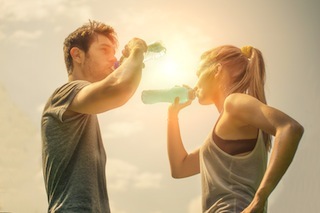 Hydration. It seems like it should be so easy: drink some water, go about your day, the end. If only it was that simple. In fact, there are many (often contradictory) opinions out there about what we should be drinking, and how much, and when, especially for the athletes among us. I have written about hydration before, and kept up to date with breaking research in recent years. Now, as I am working on the completely revised, updated, and expanded edition of The Primal Blueprint (slated for release in December 2016), I’d like to share a more sophisticated and nuanced opinion on the subject. As you might recall, in the original Primal Blueprint I essentially said, “obey your thirst like Grok did” and left it at that. So let’s dig a little deeper, especially for those of us who are active and athletic.
Hydration. It seems like it should be so easy: drink some water, go about your day, the end. If only it was that simple. In fact, there are many (often contradictory) opinions out there about what we should be drinking, and how much, and when, especially for the athletes among us. I have written about hydration before, and kept up to date with breaking research in recent years. Now, as I am working on the completely revised, updated, and expanded edition of The Primal Blueprint (slated for release in December 2016), I’d like to share a more sophisticated and nuanced opinion on the subject. As you might recall, in the original Primal Blueprint I essentially said, “obey your thirst like Grok did” and left it at that. So let’s dig a little deeper, especially for those of us who are active and athletic.
Hydration is a critical component of optimal health. It is important for digestion, muscle contraction, circulation, thermoregulation, and neurologic functioning, among others. My seemingly flippant “obey your thirst” message actually has good scientific support. Your body has a built in, well-regulated thirst mechanism that will tell you if you need to drink additional fluids. If you’re low, besides initiating thirst to get you to drink more, your body is able to respond by releasing an anti-diuretic hormone called vasopressin, or AVP, to retain more fluid in your body. To hydrate optimally, you simply need to tune in to your body’s thirst sensations, tailor your fluid intake to your individual needs, and make appropriate adjustments for exogenous factors like climate (drink more if it’s hot) and exercise (replenish water lost through sweat). Obviously, these outside influences should be reflected in your thirst. There is no good evidence that we should all adhere to conventional wisdom’s old 8×8 rule: drink at least eight eight-ounce glasses of water every day without fail. Nor is there any benefit to drinking even greater quantities of water; in fact drinking too much can bring about the dangerous condition of hyponatremia—where excess fluid compromises the all-important sodium balance in your blood. This situation can quickly become debilitating and even fatal. You may have heard the news stories in recent years of novice marathon runners losing consciousness, or radio station contestants drinking themselves into the ER or even to death.
Nothing I’ve seen in the past few years, since the last time I updated The Primal Blueprint, makes me inclined to change my advice for the average healthy person who isn’t engaged in heavy physical activity. Drinking to thirst is still the best bet. Remember, too, that we get up to 20% of our hydration needs met through food, especially watery fruits and veggies, which you should be eating plenty of if you are eating primally. If you are eating a healthy (Primal!) diet, drinking when you feel thirsty, and aren’t exhibiting signs of dehydration (headaches, dizziness, very dark urine, etc.), you should be fine.
And don’t forget about salt. Dietary sodium has been positioned in a negative light by conventional wisdom. I have argued that that is unfounded, and scientists are beginning to reconsider the anti-salt crusade as well. Sodium, which we get from salt (NaCl—high school chemistry anyone?), helps transport water through the walls of your small intestines, where 95% of fluid absorption takes place. You need salt, and we primal peeps are probably getting less of it compared to the rest of the population since a large proportion of most Americans’ dietary sodium comes from processed foods. In fact, when transitioning from a Standard American Dietary pattern to a primal/paleo style pattern, it’s possible to become deficient in sodium and develop a need to consume supplemental sodium to get rebalanced. In general, don’t be afraid to salt your food. If you are not eating while you drink, you can even add a pinch of salt to your water to boost absorption (keep reading for a further recommendation that will really blow your mind).
Advice for Fitness Enthusiasts (and Other High Energy, High Calorie Burners)
For athletic types—anyone who goes out and works up a serious sweat—the hydration issue is considerably more complicated, and my view on how they should hydrate has become more nuanced. For us folks, especially those of you engaged in endurance sports such as long distance running or triathlons, or back-to-back events such as CrossFit competitions featuring multiple physical efforts in the same day, or those doing physical labor in warm climates, you are putting your body under considerable physical and metabolic stress. (I won’t lecture you about chronic cardio here, but you know how I feel about it). You have greater-than-average hydration needs both because you are losing fluids through sweat and because you need to be properly hydrated in order to perform at a high level. Your body (your muscles, your digestive tract, your brain) is really counting on water, just when it is being depleted. While some amount of incidental dehydration is inevitable during intense exercise, being as well-hydrated as possible is important for performance, thermoregulation, and recovery, and it can be difficult to right the ship if your hydration starts being compromised.
So what is the responsible, hydration-conscious athlete to do? Here is where it gets tricky. Athletes need to consider a range of factors, including exercise duration and intensity, environment and temperature, training status, heat acclimatization, previous hydration level, diet, body mass, and so on. It is clear that there is no single best practice for all athletes. However, there are some guidelines that have been suggested by some of the leading researchers in hydration and athletic performance.
What to Drink
While plain water is ok, you are better off consuming a solution of water, salt, and glucose/sucrose. WAIT, STOP THE PRESSES! Did Mark Sisson really just recommend adding sugar to water?!? I did. Hear me out. For maximal water absorption, the body requires sodium and glucose/sucrose to facilitate the transport of water through channels in the small intestine. Please be clear, this sugar is not for fueling, and it’s not a lot. Your food/fuel is a totally different issue for a different post. What the experts are now talking about here is a solution of 16 oz of water, a pinch of salt, a teaspoon of maple syrup (because it has a good composition of sucrose and glucose).
I do not advise you to rely on engineered “sports nutrition” drinks in general. They are usually carbohydrate dense because they are designed to combine hydration with fueling. Many follow the long-standing advice to consume a solution of 7% glucose, although Dr. Stacy Sims (exercise physiologist, nutrition scientist, and co-founder of Osmo Nutrition) recommends a 2-4% osmolality solution for optimal hydration. It can be extremely difficult to know how concentrated your drink is, and you might purposefully be making it extra concentrated if you are using one of those powdered formulas you mix yourself. This is a problem because fluids that are too concentrated and too sugary, like many sports drinks on the market, can sit in your stomach (if you have experienced the dreaded sloshing belly during a marathon know about slow gastric emptying). Then, once the sugary fluid is in your digestive tract, your body actually draws stored water into the intestine to dilute them. This has a net dehydrating rather than a rehydrating effect. Ouch! Time to change the narrator’s text in the sports drink commercials, eh? Note that anything like a lemonade or fruit juice or even coconut water can also be problematic because they too have too much glucose to provide ideal hydration.
What’s more, engineered sports drinks like the ubiquitous Gatorade often have undesirable ingredients like dyes and chemical preservatives that I don’t want in my system. (Unless they sign me to a multi-year endorsement deal; how does “Gatorade presents MarksDailyApple.com” sound?) If you do decide to use one of these products, dilute it with water unless you know it is specifically engineered to have a lower osmolality.
When and How Much to Drink
There are many respected scientists, including the inimitable Dr. Timothy Noakes (author of Waterlogged, world-renowned expert on hyponatremia, long considered one of the leading endurance exercise physiologists in the world, and recent convert to primal-style eating!) and Drs. Marty Hoffman and Kerry Hoffman (Director of Medical Research and Medical Director of the Western States 100-mile endurance run, respectively) who recommend drinking to thirst even for extreme endurance athletes. This means no schedule, no “per hour” guidelines, all idiosyncratic and intuitive. However, there is also ample evidence that the thirst sensation can be suppressed even with systemic dehydration. Plus, in a high-stress situation like an Ironman, or during a high stress block of training or living (jet travel, etc.), there is a real concern that individuals might become too mentally and physically taxed to be attuned to their thirst. This could happen in the middle of an endurance event or ultra race, where so much focus is on pacing/competing instead of on biofeedback, or it could happen over time from the accumulation of ambitious workouts.
Brad Kearns, my Primal Endurance co-author and Primal Blueprint Publishing sidekick, sustained a serious medical setback this past summer (severe dehydration and emergency appendectomy—sordid details are in the book for your reflection and edification) despite his decades of experience as a seemingly optimally hydrated athlete. This happened in June during a week of 100-plus-degree heat and two high-intensity sprint/strength workouts over a four-day period. The lesson here is that as the athlete stacks up big workouts over time, it’s possible to bring a bit of dehydration to the table at successive workouts. You might not notice your condition working at your desk the day before you bang out sprints and max effort high jumps in 106 ºF heat, but entering a hard workout slightly underhydrated, then burning up more energy and generating more heat at the workout, might throw you into catch-up mode that could spiral downward over time. Yes, even if you faithfully down fluids right after the workout until your thirst is temporarily quenched.
Brad recalls, “Of course I drank like a fish after my high intensity session on Tuesday in the heat, rested carefully for a couple days, then hit it hard again Friday. I felt fine—recovered, hydrated, and explosive during the workout. But that pretty much always happens during a workout when the juices get flowing! After the Friday workout, I started to not feel so good (appendix acting up as I would learn later). As I convalesced in bed over the weekend, the health disturbance was enough to put my thirst mechanism out of order. By Sunday, I had burned up an organ and received nine IV bags in succession before and after the surgery, until I was finally declared rehydrated.”
If you are exercising primally, you are not putting sustained, intense stress on your body (by design!), so you can safely drink to thirst. Likewise if you’re only out there for an hour or two in temperate conditions. If you are exercising for more than a few hours, or in extreme conditions, I think it is wise to have a hydration plan. This does not mean a hard-and-fast rule to drink a certain amount per hour, despite what some experts recommend. This means reminding yourself to drink periodically and doing so if it feels comfortable. It also means going into races adequately trained, having tested and practiced hydration strategies, and being heat acclimatized if appropriate. But by all means, never force yourself to drink! This is a primary way people induce hyponatremia, which can be fatal.
Advice for Women
As Dr. Sims reminds us, “women are not small men.” Most of what researchers “know” about hydration comes from studies of men, whose hydration needs can be very different from women’s due to female hormone cycles. In particular, for women during the luteal phase (between ovulation and onset of period), when estrogen and progesterone are high, blood volume and total body sodium are low. At the same time, women’s homeostatic threshold for AVP release and thirst are lowered. The effect of these together is that women are physiologically closer to being hyponatremic and so have to be particularly careful not to overhydrate (this might be why women are at greater risk for exercise-associated hyponatremia). Dr. Sims also advises that women in the high hormone phase sodium preload before exercise and hydrate using a water-sodium-glucose/sucrose solution as described above (this advice applies to all women, but is it especially important for female athletes).
The Bottom Line
For the average person, people engaged in shorter-duration exercise, and endurance athletes not immediately preparing for or actively engaged in long workouts or races, drinking to thirst is still the best recommendation.
Drink throughout the day. Keep water handy so it is available if you want it, but don’t be a slave to it. Remember, we can only absorb so much water. Drinking more doesn’t necessarily make us more hydrated. If you are a Nalgene addict who is in the bathroom every 30 minutes, you are just cycling water in and water out with no actual physiological benefit.
Eat lots of high water-content fruits and vegetables.
Don’t be afraid of salt. Salt your food to taste. Add a pinch of salt (and a teaspoon of maple syrup) to your water. Athletes, especially women in the luteal phase of their menstrual cycles, should consider sodium preloads, particularly before hot workouts.
Athletes should consider hydration preloads before extreme events or training phases, particularly in hot weather.
Never force yourself to drink or drink past the point of comfort.
Most sports drinks are not your friend. Look for ones that use a combination of glucose and sucrose instead of fructose, maltodextrin, sucralose, or xylitol, and avoid ones with a lot of unnatural ingredients like dyes. In a race situation, if you are desperate you can drink whatever is available at the aid station, but dilute it with water.
Remember, hydration needs and optimal strategies are idiosyncratic. Just as I advise you to experiment with your diet to find what works best for you, do the same with hydration. Especially if you are an athlete, you must do the tinkering in training so you know what your body needs and how it responds.




December 14, 2015
PRIMAL KITCHEN™ Dark Chocolate Almond Bars Have Landed!
 Throughout the years, I’ve rolled out several recipes for Primal Energy Bars on Mark’s Daily Apple—do-it-yourself treats packed with energy, protein, and healthy deliciousness. I want to thank you for experimenting with me, because it’s brought us to TODAY…the official launch of my latest PRIMAL KITCHEN™ creation—Dark Chocolate Almond Bars.
Throughout the years, I’ve rolled out several recipes for Primal Energy Bars on Mark’s Daily Apple—do-it-yourself treats packed with energy, protein, and healthy deliciousness. I want to thank you for experimenting with me, because it’s brought us to TODAY…the official launch of my latest PRIMAL KITCHEN™ creation—Dark Chocolate Almond Bars.
They are everything you’d expect in a bar that bears the Primal name. And they boast 15 grams of protein, just 3 grams of sugar and 8 grams of net carbs per bar, and 170 milligrams of potassium. Those are some impressive stats if I do say so myself!
The Taste: I don’t go for the sickly sweet bars that are really just Snickers disguised in a “healthier” package, but I did like the idea of combining nutty crunch with decadent rich chocolate and chewy caramel. So, I whipped together dark chocolate, Turkish almonds, roasted pumpkin seeds, a caramel coating, and a touch of coconut for a subtly sweet but totally satisfying taste.
The Ingredients: Like all PRIMAL KITCHEN™ products, you can rest assured there are no artificial ingredients in my Dark Chocolate Almond Bars. Just: Almonds, Roasted Pumpkin Seeds, Grass-Fed Collagen, Isomalto-Oligosaccharides (Cassava Root), Water, Coconut Flakes, Honey, Natural Flavors, Coconut Oil, Bitter Chocolate, Cocoa Powder, Himalayan Pink Salt, Monk Fruit Extract, Tocopherols (Vitamin E).

Let’s break that down in terms of nutritional benefit.
Grass-fed Collagen: The ancestral diet was loaded with collagen protein. Primal humans ate the odd bits and tougher cuts of beef that made up the connective tissue of animals, but nowadays, these parts of the meat get thrown away…because who wants to eat tendons and skin raw? Well, some of you hard-core Groks maybe…but, we can cook them.
PRIMAL KITCHEN™ protein bars are made with grass-fed collagen protein from bovines pasture-raised in Brazil. This type of grass-fed collagen has been shown to help reduce joint pain, improve sleep quality, support skin, hair and nail growth, and enhance digestion.
The grass-fed collagen protein that’s in my protein bars is packed with glycine, and studies have shown that glycine can counteract the effects of methionine. Why do we care? Because animal foods like muscle meat, eggs and dairy get a bad rap because they’re high in the amino acid methionine, which animal trials have shown can decrease life span. With as much collagen per bar as in a cup of bone broth, now we Groks can enjoy all the benefits of a protein-rich diet.

Inulin: Primal Kitchen’s Dark Chocolate Almond Bars are a terrific source of fiber in the form of inulin. Inulin is a prebiotic fiber that feeds the trillions of foreign cells in our digestive tracts. In other words, it’s food for your gut flora, and trust me, you want your gut flora fed and happy! Your gut microbiome controls factors into nearly every aspect of your health—your digestive, cognitive, emotional, psychological, immune, metabolic and liver health.
Inulin is also being studied as a possible weight loss aid. Eating prebiotic fiber in the form of inulin helps you feel fuller, faster—so you don’t go overboard on calories—and it won’t spike your blood-sugar levels. Preliminary research supports inulin’s effectiveness as an appetite suppressant.
Monk Fruit: Also called Luo Han Goa, monk fruit is a Chinese herb cultivated for centuries by Buddhist Luohan monks. Much like stevia, it’s a delicious and natural sweetener without all the calories of sugar.
Nuts: We’ve added calcium-rich almonds, and pumpkin seeds, a terrific source of omega-3 fatty acids, carotenoids, magnesium, and zinc.
Paleo Plus: My Dark Chocolate Almond Bars are paleo approved, and gluten, grain, dairy and soy free!
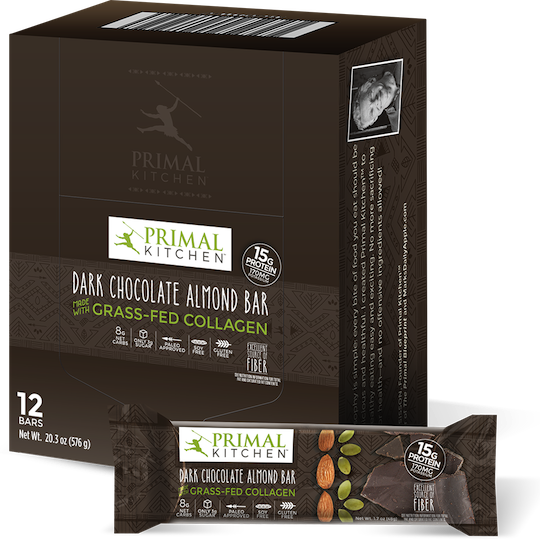
I’m sure you’ll want to be on of the first in the community to taste these bars. Order today and you’ll receive FREE domestic shipping from PrimalBlueprint.com. Or, if you prefer, you can order PRIMAL KITCHEN™ Dark Chocolate Almond Bars from Thrive Market.
I hope you enjoy my bars as much as I do. They’re a hit at the office and my family is loving them. Please let me know what you think in the comments below.




December 13, 2015
Weekend Link Love – Edition 378
 Research of the Week
Research of the WeekExercise enhances brain plasticity.
High starch, low fiber diets are linked to type 2 diabetes in women.
Vegetarian and vegan diets are associated with mental health issues. They said it, not me.
Coffee consumption reduces DNA breaks.
Standing for just a quarter of the day is associated with lower body fat in men, and lower abdominal fat and a reduced risk of obesity in women. Not bad.
Vitamin D may fix damaged nerves in multiple sclerosis patients.
Cold exposure-related weight loss seems to be mediated by changes to the gut bacteria.
Low-carb, high-protein diets: still very safe for the kidneys.
New Primal Blueprint Podcasts

Episode 97: Andrew Magness: As a husband, father, physicist, teacher, writer, conservationist, apocophiliac (look it up), coach, writer, athlete, adventurer, endurance junkie, climber, and surfer, Andrew Magness is a true renaissance man. Over the course of a long career of rock climbing, mountaineering, marathon swims, 10-day adventure races, and ultra-distance bike rides through the dead of winter Andrew has discovered how to excel at extremely demanding physical feats while staying healthy and avoiding the worst kinds of injuries. In this episode, Andrew shares what he’s learned.
Each week, select Mark’s Daily Apple blog posts are prepared as Primal Blueprint Podcasts. Need to catch up on reading, but don’t have the time? Prefer to listen to articles while on the go? Check out the new blog post podcasts below, and subscribe to the Primal Blueprint Podcast here so you never miss an episode.
4 Ways Winter Affects Your Physical Health
Also, be sure to check out and subscribe to the Primal Endurance Podcast.
Interesting Blog Posts
Media, Schmedia
Elevated zonulin may cause non-celiac gluten sensitivity.
A fifth of Americans are “almost constantly” online.
Everything Else
Why Neanderthal faces looked so strange.
Is that a ninja turtle?
Yeah, you still need 7-8 hours of sleep.
Help a Florida family expand their sheep and lamb farm. They’re doing things right (rotational grazing, grain-free, grass-only feeding).
The earliest camp art.
Funny, that.
Recipe Corner
This coco-nutty dark bar makes a great gift for chocolate lovers. Or you can just eat the entire thing yourself.
I’ll bet you’ve never tasted anything like Persian lime parsnip purée.
Time Capsule
One year ago (Dec 15 – Dec 21)
The Call of the Wild – You listening?
The Pros and Cons of Comparing Yourself to Others – We all do it. Here’s how to do it right.
Comment of the Week
So excited to see this! Just placed an order. I run distance (yeah yeah I know but its addictive) so I can’t wait to read this. I follow primal guidelines in all other areas of my life except that damn chronic cardio.
– I’ve got you covered, Bree!




December 12, 2015
Chicken Skin Chips
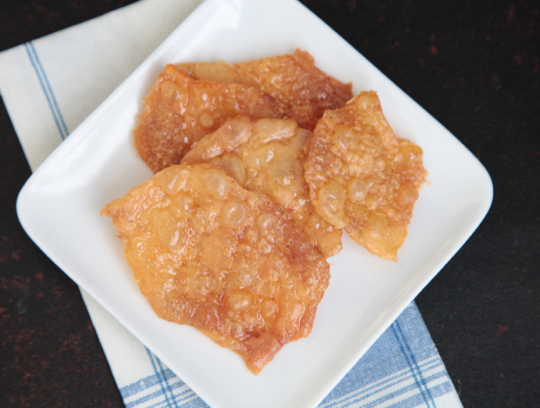 Chips made from root vegetables or kale are all well and good, but once you’ve tried chicken skin chips they’ll be the only chip you crave. Like regular potato chips, the salty, oily flavor is truly addictive and the light, crispy texture shatters like glass when you take a bite. The only problem with these chips is that they require self-control. Although, if you’re going to eat one too many chips, then they might as well be made from chicken skin.
Chips made from root vegetables or kale are all well and good, but once you’ve tried chicken skin chips they’ll be the only chip you crave. Like regular potato chips, the salty, oily flavor is truly addictive and the light, crispy texture shatters like glass when you take a bite. The only problem with these chips is that they require self-control. Although, if you’re going to eat one too many chips, then they might as well be made from chicken skin.
Animal skin is high in fat, collagen and gelatin. All three are good for joints, nails, hair, and skin. Of course, the healthier the chicken, the healthier the skin will be (pastured, organic, and antibiotic free are labels to looks for).
That being said, chicken skin does have a good amount of omega-6, so don’t regularly eat a whole batch of these chips by yourself.
Fatty chicken skin has so much flavor that these chips are perfect with just a sprinkle of salt, but go ahead and experiment with anything you have in your spice rack. Cayenne, curry powder, paprika and dried dill are some flavors to try.
Servings: 2
Time in the Kitchen: 1 hour
Ingredients and Equipment:
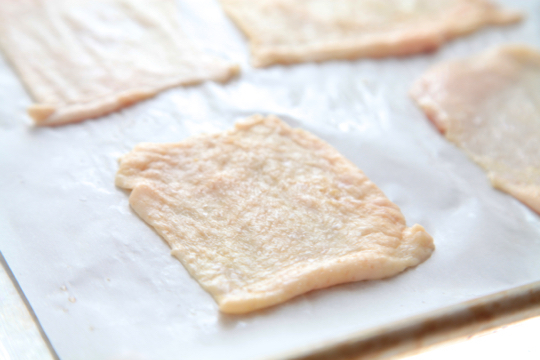
Skin from one whole chicken or 4 thighs
Salt
Parchment paper
2 rimmed baking sheets
Instructions:
Preheat oven to 350 °F/177 °C.
Line a baking sheet with parchment paper.
Cut the chicken skin into pieces that are 3 to 4 inches across when stretched out. Lay the pieces down, stretched flat, on the baking sheet lined with parchment paper. Sprinkle lightly with salt or any other seasonings.
Place another piece of parchment paper over the skin and set a baking sheet on top. (This covering prevents the skins from burning and curling up)
Bake 45 minutes, or until the chicken skin is golden and very crispy.
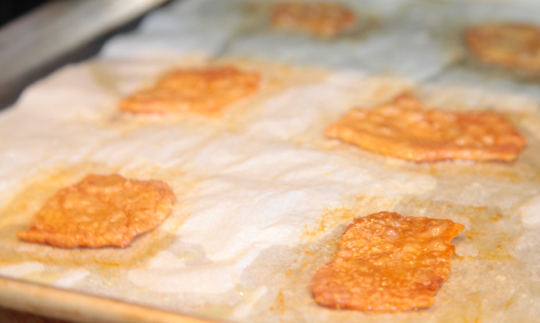
For the best flavor and texture and for freshness, eat the chips within a day.
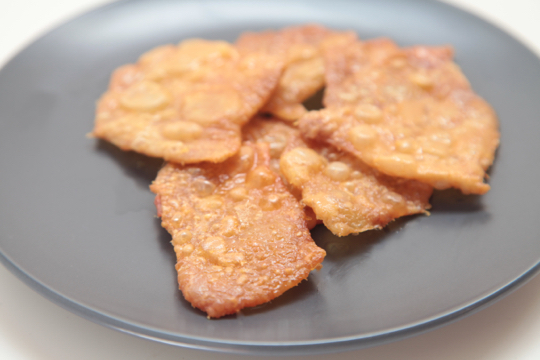
Not Sure What to Eat? Get the Primal Blueprint Meal Plan for Shopping Lists and Recipes Delivered Directly to Your Inbox Each Week. Now Available as an App!



December 11, 2015
Saying Goodbye to Constant Hunger, Lethargy and Frustration
It’s Friday, everyone! And that means another Primal Blueprint Real Life Story from a Mark’s Daily Apple reader. If you have your own success story and would like to share it with me and the Mark’s Daily Apple community please contact me here. I’ll continue to publish these each Friday as long as they keep coming in. Thank you for reading!
 I really don’t have too many before pictures, as you can imagine I avoided the camera, not liking the way I looked. I have ever so many after pictures, as now I’ll pose at the first sign of a camera because I like the way I look so much!
I really don’t have too many before pictures, as you can imagine I avoided the camera, not liking the way I looked. I have ever so many after pictures, as now I’ll pose at the first sign of a camera because I like the way I look so much!
My “before” picture (below) was taken in early 2011 at age 59, with my first granddaughter. For most of my life, I had always been slender and fit, being 5’5 1/2″ and weighing around 125. I’d always had normal cholesterol counts and normal blood pressure. Apart from occasional colds, I was in excellent health and didn’t think much about what I ate.
 Looking back, things started slowly changing for me in my early 50’s. I was very slowly gaining weight, and gaining it around my waist. I probably only gained about 5 lbs a year, but it was steady, and by the time this picture was taken, I weighed 140 lbs and had started dressing in loose clothing to downplay my increasing waist line. I didn’t like it. I didn’t like the way I looked and the way I felt. I was tired, didn’t feel comfortable with myself and I was frustrated.
Looking back, things started slowly changing for me in my early 50’s. I was very slowly gaining weight, and gaining it around my waist. I probably only gained about 5 lbs a year, but it was steady, and by the time this picture was taken, I weighed 140 lbs and had started dressing in loose clothing to downplay my increasing waist line. I didn’t like it. I didn’t like the way I looked and the way I felt. I was tired, didn’t feel comfortable with myself and I was frustrated.
I decided to go on a calorie restricted diet and bought processed diet food to have on hand. It was such a bad idea on so many levels! I was constantly hungry, as lethargic as ever and lost only two pounds, which were immediately regained when I was too hungry to stand it anymore, and ate normally. Is this the normal aging process, I wondered? I come from a long lived family and steadily gaining 5 lbs a year for the next 25 years could end up very badly for me!
Unbeknownst to me, my son, in his early thirties, was not happy with his weight and lack of energy. His wife had also had problems with high cholesterol counts since she was a teenager, and was having a hard time controlling it. My son started to do internet searches and came across Mark Sisson’s information on the Primal lifestyle. My son researched it thoroughly and started the diet during the summer of 2011, and when I went to visit him and my daughter-in-law the following October, my son had completed approximately three months of paleo and was wildly enthusiastic about it.
His wife saw her cholesterol levels drop almost to normal. His weight dropped to where it was in high school and his energy level greatly increased. I have to be honest, I didn’t research paleo, I didn’t even know much about it. My son simply instructed me that this was the way I was to eat from now on!
Knowing how much research my son did on anything he engaged in, I immediately got the list from him on how to eat, took it home and got started. The first six months I was off and on, and not entirely committed, but I started losing weight, even though I was never left hungry. Then, I ended up going full paleo.
 This “after” picture was taken, January 2014. I feel so comfortable with the way I look. I feel like the person I am inside is reflected by my outside appearance. And, interestingly, at my checkup last May, my cholesterol levels remain normal as does my blood pressure, but my weight is 125 (and it’s been stable at 125 for close to a year now) and I’m no longer 5’5 1/2.” I’m now 5’6.1.” No, paleo didn’t make me grow, but with my increased energy level I decided to start taking yoga classes (which I’d always wanted to learn) and evidently I’ve been slumping my whole life, I now stand up straight and have discovered that I’m taller than I’ve always thought I was!
This “after” picture was taken, January 2014. I feel so comfortable with the way I look. I feel like the person I am inside is reflected by my outside appearance. And, interestingly, at my checkup last May, my cholesterol levels remain normal as does my blood pressure, but my weight is 125 (and it’s been stable at 125 for close to a year now) and I’m no longer 5’5 1/2.” I’m now 5’6.1.” No, paleo didn’t make me grow, but with my increased energy level I decided to start taking yoga classes (which I’d always wanted to learn) and evidently I’ve been slumping my whole life, I now stand up straight and have discovered that I’m taller than I’ve always thought I was!
Sidenote – One day at yoga our instructor stopped us and said, “Ladies, don’t think that doing all this exercise will change your body if you continue to eat bad food. That’s all I have to say about that.” But I knew just what she meant, that eating the standard American diet with white flour, white sugar, additives, preservatives, low calorie, high starch foods, devoid of any nutritional value, would (as I had found out before the paleo), leave you hungry and continually gaining weight.
Now, you might ask, do I think I will continue indefinitely with the primal lifestyle? At my last checkup the doctor suggested I be tested for Celiac’s Disease as it runs in my family. Although I’d never been aware of having any symptoms, I tested positive, which means no more gluten containing products, ever. And I’m so okey with that – a disease that makes you unable to eat junk food is not a bad thing! So yes, I’m following the paleo diet and lifestyle and there’s no going back, which I wouldn’t want to do as I feel good, like the way I look and have energy to thoroughly enjoy my beloved granddaughter.
Catherine




Mark Sisson's Blog
- Mark Sisson's profile
- 199 followers



